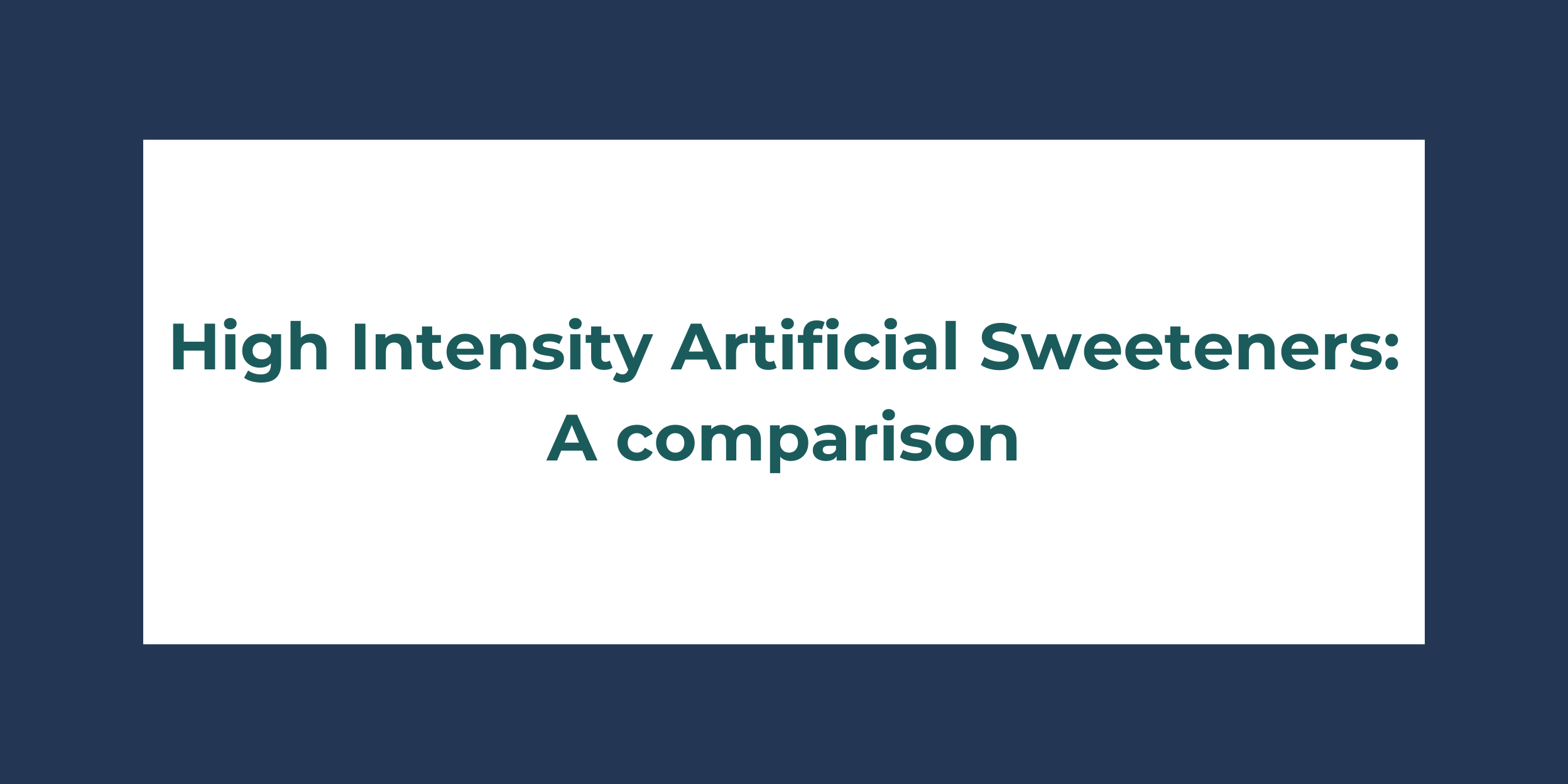In this blog, we will be comparing the synthesis process, sweetness levels, applications, drawbacks and side effects of these High Intensity artificial sweeteners:
- Aspartame
- Saccharin
- Neotame
- Acesulfame K
- Sucralose
Synthesis process of Artificial Sweeteners
The chemical synthesis process of these High intensity artificial sweeteners is:
- Aspartame: Synthesised from the condensation of L-phenylalanine methyl ester with L-aspartic acid, followed by neutralisation and crystallisation.
- Saccharin: Synthesised via the Clausen-Schmidt condensation of o-sulfobenzoic acid with ammonia in the presence of nitrous acid.
- Neotame: Synthesised from 3,3-dimethylbutyraldehyde and L-aspartic acid using a catalytic hydrogenation process.
- Acesulfame K: Synthesised by the acetylation of acetoacetic acid with potassium hydroxide, followed by oxidation and neutralisation.
- Sucralose: Synthesised by selective chlorination of Sucrose, followed by purification and isolation.
Sweetness Levels of Artificial Sweeteners
The sweetness levels of these High intensity artificial sweeteners are:
- Aspartame: Approximately 200 times sweeter than sucrose.
- Saccharin: Around 300 to 400 times sweeter than sucrose.
- Neotame: About 7,000 to 13,000 times sweeter than sucrose.
- Acesulfame K: Roughly 200 times sweeter than sucrose.
- Sucralose: Approximately 600 times sweeter than sucrose.
Applications of Artificial Sweeteners
The applications of these High intensity artificial sweeteners are:
-
Aspartame:
- Commonly used as a low-calorie sweetener in beverages such as soft drinks, fruit juices, and flavoured waters.
- Used in a variety of foods, including desserts, dairy products, and confectionery, to provide sweetness without adding calories.
- Often found in pharmaceuticals and oral care products as a sweetening agent.
- Used in tabletop sweeteners and sugar-free chewing gum.
- Suitable for use in cooking and baking, providing sweetness in recipes without adding significant calories.
-
Saccharin:
- Used as a sweetening agent in beverages, including soft drinks, fruit juices, and alcoholic beverages.
- Found in a variety of foods, such as canned fruits, jams, and jellies, to enhance sweetness.
- Often used in pharmaceuticals and personal care products, including toothpaste and mouthwash.\Used in tabletop sweeteners and sugar-free chewing gum.
- Sometimes used in the preparation of low-calorie or diabetic-friendly foods.
-
Neotame:
- Used as a high-intensity sweetener in a variety of foods and beverages, including soft drinks, dairy products, and desserts.
- Suitable for use in cooking and baking, providing sweetness in recipes without adding significant calories.
- Often used in pharmaceuticals and oral care products as a sweetening agent.
- Used in tabletop sweeteners and sugar-free chewing gum.
- Provides sweetness similar to sucralose but with greater stability under high-temperature processing.
-
Acesulfame K:
- Commonly used as a sweetening agent in beverages such as soft drinks, fruit juices, and sports drinks.
- Found in a variety of foods, including desserts, dairy products, and confectionery, to provide sweetness without adding calories.
- Often used in tabletop sweeteners and sugar-free chewing gum.
- Suitable for use in cooking and baking, providing sweetness in recipes without adding significant calories.
- Sometimes used in combination with other sweeteners to enhance sweetness profiles.
-
Sucralose:
- Widely used as a sweetening agent in beverages such as soft drinks, fruit juices, and flavoured waters.
- Found in a variety of foods, including desserts, dairy products, and baked goods, to provide sweetness without adding calories.
- Often used in tabletop sweeteners and sugar-free chewing gum.
- Suitable for use in cooking and baking, providing sweetness in recipes without adding significant calories.
- Used in pharmaceuticals and oral care products as a sweetening agent.
Drawbacks of Artificial Sweeteners
-
Aspartame:
- Phenylketonuria (PKU) Risk: Aspartame contains phenylalanine, which can be harmful to individuals with phenylketonuria (PKU), a rare genetic disorder.
- Stability Issues: Aspartame may break down when exposed to high temperatures or prolonged storage, leading to loss of sweetness.
-
Saccharin:
- Bitter Aftertaste: Saccharin can leave a bitter aftertaste, particularly at high concentrations.
-
Neotame:
- Limited Research: Due to its relatively recent introduction, there may be limited long-term studies on the safety of neotame compared to other sweeteners.
- Potential Allergenicity: Some individuals may be allergic to neotame, although such cases are rare.
-
Acesulfame K:
- Stability Issues: Acesulfame K may degrade at high temperatures or under acidic conditions, impacting its sweetness and usability in certain applications.
- Bitter Aftertaste: Acesulfame K can leave a bitter aftertaste, particularly at high concentrations.
-
Sucralose:
- Digestive Issues: Some individuals may experience digestive discomfort, such as bloating or gas, when consuming large amounts of sucralose.
- Environmental Concerns: Concerns have been raised about the environmental impact of sucralose, as it may not break down easily in water treatment systems.
Health Concerns
-
Aspartame:
- Phenylketonuria (PKU) Risk: Aspartame contains phenylalanine, which can be harmful to individuals with phenylketonuria (PKU), a rare genetic disorder.
- Possible Carcinogenicity: While regulatory agencies consider aspartame to be safe for human consumption, some studies have suggested a potential link to cancer
- Headaches: Some people report experiencing headaches after consuming aspartame.
- Allergic Reactions: Rare cases of allergic reactions to aspartame have been reported, including hives and difficulty breathing.
-
Saccharin:
- Bladder Cancer: Some studies link saccharin consumption to an increased risk of bladder cancer
- Digestive Issues: Some individuals may experience digestive discomfort, such as bloating or diarrhea, after consuming saccharin.
-
Neotame:
- Allergic Reactions: Some individuals may be allergic to neotame, although such cases are rare.
- Digestive Issues: Like other artificial sweeteners, neotame may cause digestive discomfort in some people, such as bloating or gas.
-
Acesulfame K:
- Possible Carcinogenicity: While regulatory agencies consider acesulfame K safe for human consumption, some studies have suggested a potential link to cancer
- Headaches and Nausea: Some individuals may experience headaches or nausea after consuming acesulfame K.
-
Sucralose:
- Gastrointestinal Disturbances: Some people may experience gastrointestinal issues, such as bloating, gas, or diarrhea, after consuming sucralose.
- Migraines: There have been reports of sucralose triggering migraines in sensitive individuals.
- Effect on Gut Microbiota: Some studies suggest that sucralose may alter the composition of gut bacteria, although the significance of this effect on human health is not yet fully understood.
Visit us here to explore our range of Artificial Sweeteners and other alternative sweeteners.








